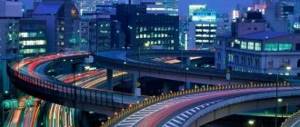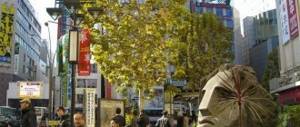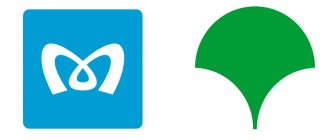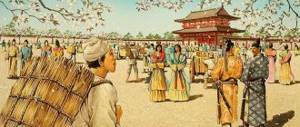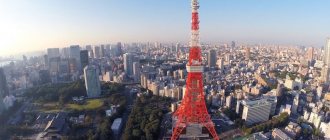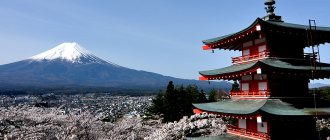Tokyo is the political and economic symbol of Japan, one of the most populated metropolises on the planet and the world's largest financial and cultural src=»https://mygeografi.ru/wp-content/uploads/2018/07/tokio.jpg» class=» aligncenter" width="600″ height="424″[/img]
Why financial is clear; the Tokyo Stock Exchange has long outdone similar exchanges in New York and London, which once divided the whole world among themselves. And Tokyo became a cultural center after the war, when Japanese tycoons, who began to become fabulously rich from American investments, began to buy up world cultural treasures in whole trains and transport it all to Tokyo in order to show the whole world that Japan is famous not only for its samurai. And it would be all the more interesting for many to know that Tokyo was not always the capital of Japan, and was not even always called Tokyo.
From the history of Tokyo
The original name of the city is Edo. If you translate this beautiful oriental word from Japanese into Russian, it will sound very prosaic: “mouth of the river.” Indeed, the historical center of modern Tokyo is located exactly at the place where the inconspicuous river flowed into what is now Tokyo Bay (the Edo Sea, or the Inner Bay in ancient times).
The heavily swampy and therefore inaccessible coastline from land attracted local pirates. They set up their bases in numerous small bays to distribute the stolen goods. However, this state of affairs did not suit the local ruler. In 1195, a fortification was built at the mouth of the Sumida-Gawa River, where a garrison was placed, which very successfully acted against the pirates, and eventually expelled them from the western shore of the bay forever.
Gradually the fortification expanded, the area was gradually drained and populated by peasants and artisans arriving from the depths of the country. And soon this land had to be defended from more significant enemies - nobles rebelling against the government and their well-armed samurai, who strove to seize someone’s possessions at any opportunity.
In 1457, a fairly large and powerful stone castle, called Edo, was erected on the site of the fortification. Another 150 years later, on the shores of a strategically convenient bay, a huge city of the same name stretched out at that time.
In those days - the 16th-17th centuries - there was an active penetration of Christians into the Japanese islands, mainly Catholic Jesuits, who began their expansion from the south of the country, and, arming local princes who had adopted Christianity along with their subjects, began to threaten the then capital of Japan - Kyoto . An internecine war began, in which the “Edo Sea” acquired very important strategic importance.
The Emperor of Japan, who had exclusively spiritual power, and his government moved from the capital to the well-fortified Edo. In fact, the nobles who ruled the country still met in Kyoto, directing military operations from there against the rebel southern princes. A road was built between Kyoto and Edo, along which communication was carried out between the two cities, and when the Europeans were expelled from Japan, and all the Christian Japanese were killed, Edo turned into what, for example, New York is now for the United States. Although the political center remained in Kyoto, Edo became the economic, cultural and religious capital. Even then, its area exceeded the largest cities in Europe - Rome, Paris, Vienna and London, and by the beginning of the 18th century its population reached a million people.
How did the name Tokyo come about?
Japan's self-isolation continued until the mid-19th century. However, immediately after the country opened its ports to foreign trade, Edo became the official capital and was renamed Tokyo (translated as the Eastern Capital, since the Western capital was previously Kyoto). The power of the “conservative Japanese boyars” ended, and the power of the “progressive Japanese boyars” began, which, however, did not increase the emperor’s influence on the country’s politics, but significantly increased his importance as a symbol of the complete unification of the nation and the economic and cultural development of the country.
Tentacles of new railways stretched from Tokyo to all regions of Japan. Many merchant ships from all over the world began to visit Tokyo Bay every day. The capital began to absorb all the surrounding cities, merging with them into one conglomerate. Already in the second half of the 19th century, almost all foreign consulates and trade missions moved from Tokyo to the nearest large city of Yokohama - there was simply no room for new structures in Tokyo itself.
The overpopulation of the city caused many problems, and one of the worst was earthquakes, which often destroyed the city and killed many inhabitants. So, in 1923, as a result of a very strong earthquake and subsequent fire, about 100 thousand people died. Half of the city simply disappeared in fire and ruins, and Tokyo had to be restored to its previous level for decades.
However, what the Tokyo residents managed to restore then was lost again, but not from the earthquake, but from American bombing, with the help of which Japan’s opponents tried to quickly persuade it to unconditional surrender. However, the Japanese were not going to give up, and by mid-1945 Tokyo was again in ruins, destroyed by fires, and the total number of victims of American attacks exceeded all losses from earthquakes in the entire history of the city .
Construction of modern Tokyo
However, with the end of the war, from which the Japanese learned very useful lessons (the main idea of which was the understanding that economic expansion is much more effective than military expansion), Tokyo literally entered a completely new era. Despite the occupation by American troops (or maybe precisely because of it), the city quickly recovered again, only this time wood was completely excluded from the range of building materials in order to prevent subsequent threats of fires.
In just one decade, a completely new ultra-modern city has grown up on the site of a huge fire. And although the problem of overcrowding in this metropolis has not disappeared, thanks to a detailed layout and widespread communications, living in Tokyo has become much easier. Within 20 years, the capital of Japan had improved so much that the Olympic Games held in the summer of 1964 were held with such success as they had never been held in almost any other country before - the whole world saw firsthand what the purposeful Japanese were capable of.
It was from this moment that the shares of everything connected with Japan began to rise uncontrollably, filling the Japanese economy with countless financial assets. The further development of the metropolis was based on the mass migration of the peasantry from agriculture due to the total automation of the latter. Work in Tokyo was found for everyone, since by the end of the 60s - mid-70s a sharp leap began to occur in the field of high-rise construction, where workers with robots, unlike other types of industry, are difficult, if not impossible, to replace.
Transport hubs. Airports.
Tokyo is the main transport hub of the country. High-speed railway lines and expressways converge on it, for which overpasses with complex multi-level interchanges are laid through densely built areas. The port of Tokyo is one of the most important centers of maritime transport (in terms of trade turnover, it is the second in Japan after Yokohama). Tokyo has two airports, but they are among the largest and most modern in the world. Narita Airport is located 80 km northeast of Tokyo and accepts international flights. Haneda Airport is located on the shores of Tokyo Bay, 14 km from the city center, and specializes in domestic transportation. Both airports are connected by rail to Main Station in central Tokyo. Shinkansen high-speed trains and express trains on the Tokaido Line (Nagoya, Kyoto, Kobe, Osaka, Hiroshima, Kyushu Island) arrive at this station. Trains on the Tohoku Line (Sendai and Morioka) arrive at Ueno Station, north of Tokyo Main Station. Trains from Niigata also arrive here. Trains to the Japanese Alps (Matsumoto) depart from Shinjuku Station. Rail services also play an important role in connecting various parts of the Tokyo metropolis, which is penetrated by an extensive network of subway lines, elevated trains and monorails. More than 25 million people use the transport system every day. Each train line in Tokyo has its own color. The Yamanote Line (green or silver with green stripes) is a 35 km ring around the central part of the city. The train makes a circle in an hour, passing 29 stops, including important transport hubs of the city (Yurakucho, Shinbashi, Shinagawa, Hibiya, Shinjuku, Ueno). The Chuo Line - orange - runs from east to west Tokyo to the suburb of Takao. During the day, trains pass through the city center almost without stopping. The city center is served by the Sobu Line (yellow). The Keihin Tohoku Line (blue) runs from the north (Omiya area in Saitama Prefecture) to the south (Ofuna area in Kanagawa Prefecture).
Tokiye goes to sea
The Japanese coped with the problem of overpopulation with their characteristic creativity - they began to build many artificial islands in the shallow sea, thus increasing the territory of the country. Over the past 100 years, enough of these islands have been built in Tokyo Bay to relocate a large portion of the population of Tokyo and surrounding cities.
At first industrial enterprises were built on them, but recently enterprises have been clearing them out and constructing residential neighborhoods and green parks. In addition, it would not be out of place to mention the fact that more than 50 percent of the adult working population of the capital is employed in the service sector.
In addition to the man-made islands in Tokyo Bay, the capital's administration also extends to two archipelagos that are located in the Pacific Ocean - one 100 km from Tokyo (Izu Islands), and the other 1000 km from it (Bonin Islands).
The national shrine of Japan, Mount Fuji, is located only 50 km from the outskirts of the city, and is clearly visible in almost any weather, even at night. Based on the condition of the clouds that often cover the top of the volcano, surrounding residents accurately determine the weather for the coming days. Within the Tokyo metropolitan area there are several national parks, such as Meiji Grove and Ueno Park. The latter, among other things, houses a large number of various museums, which are of undoubted interest to lovers of Japanese history, culture, science and technology.
In recent years, due to the increased seismic danger of the area, many projects have been submitted to the government for consideration to move the capital from Tokyo to quieter cities in the country. The government has already decided on the transfer, but the issue rests on the choice of a suitable locality, and it seems the matter has been shelved. However, even if the capital is moved from Tokyo to somewhere else, then Tokyo itself will not go anywhere - after all, such monsters of global urban planning as New York, Rio de Janeiro and Sydney, the significance of which does not suffer in the least from the fact that that the capitals of the USA, Brazil and Australia are located in smaller and lesser-known cities.
Capitals of Japan. Nagaoka-Kyo (784-794)
Nagaoka-Kyo was founded as the capital of Japan in 784 after Emperor Kanmu transferred the State Council to Heijo (today Nara). The reason for the Emperor's preference for Nagaoka-Kyo was the presence of rivers, which provided excellent water transport. However, these rivers were the cause of the city's downfall, as frequent floods and constant dampness led to various diseases among the inhabitants, which eventually forced the emperor to move the capital to Heian-Kyo in 794.
These Tokyoites are music lovers
In conclusion, I would like to tell you about one interesting fact, known only to music lovers and those associated with music. Many (if not all) musicians, when some creative and financial problems begin in their homeland, without any hesitation, pack their suitcases and equipment and go on tour to Japan. “Only in Tokyo am I accepted with open arms at any time of the year and under any circumstances,” once said the famous rock musician Michael Schenker, who once founded the legendary band “Scorpions” with his brother, and later became the frontman of the immortal “UFO” " “And only in Tokyo can I feel at home.”
For those who don’t believe, we advise you to look through the discography of all the popular musicians of the last decades - almost everyone has “live” albums with the titles “Made in Japan”, “Live in Tokyo”, “One night at Budokan” and other similar ones, or even not one album, and not two, but several at once.
How does a Japanese live?
Housing in the city is provided free of charge. This applies to those registered in the prefecture. True, this is a lot of documents, but the result will be positive. For residents of Tokyo, the minimum housing area is 20 square meters per family member. This applies to any area. Compared to minimalism, it seems fantastic for Tokyo. For a Tokyo resident, an area of 60 square meters for a family of 3 people is normal and guaranteed by the state.
The dwellings where the indigenous Japanese live are called “Danti” - areas built throughout the country for collective living. Districts with old five-story buildings, which we call “Khrushchevka”, also have the same name. They have those too! When the city was bombed and it was difficult to find housing in the country, they built communal five-story buildings just like ours. For people without a roof over their heads, getting an apartment in such a house was a happy event, a wild dream.
Even today, "Danti" is a third of the housing stock of Tokyo prefectures. Many areas are no longer residential; they are trying to revive them according to the same principle as in Moscow. To do this, you need 75% of the votes of residents. But many people cannot afford housing in the new conditions; the fees for services are so high that people vote against it. Everything depends on the wealth of these citizens.
There are cemeteries literally in the center. And this is normal for them. Between several houses. Just like in our yards. But this is rare, much more often in courtyards - sports and children's playgrounds, even stadiums. There are many houses that are ready to collapse, built with violations of technology - the Japanese are also shoddy.
Each prefecture has its own waiting list for housing. It is not given free of charge, but at a minimum rate for this category of borrowers. Try to buy the same apartment in Moscow and, I wonder, how long it will take you to do it for your salary. Big question!
Tourist Tokyo
An amazing harmony of ancient traditions and high technology reigns in the city of Tokyo. This creates the illusion of the materiality of time, which, on the one hand, is frozen in ancient monuments, and on the other hand, rushes past at breakneck speed in technical innovations. There are many attractions in Tokyo that tourists should definitely visit.
Imperial Palace
The Imperial Palace is the main and most popular attraction in Tokyo. It is located on the territory of the same Edo Castle. Built in the middle of the 19th century.
The fortress is located in the center of the metropolis and includes 2 ground floors and 1 underground. Massive walls and wide ditches isolate this symbol of statehood from the bustle of the world and simply attract the attention of tourists. The architecture is in a traditional style, restrained and simple. Unfortunately, you can only admire this majestic building from afar. Entrance to the palace for outsiders is prohibited. But even from a distance, the imperial palace is remembered for its grandeur and aura of power.
Metropolitan.
The history of the Tokyo metro begins on December 30, 1927: on this day, a private company, then called Tokyo Chika Tetsudo (Tokyo Underground Railway), opened the first subway line between the capital's Ueno and Asakusa stations with a length of only 2.2 km. Currently, Tokyo has 12 metro lines with a total length of more than 230 km. These branching lines cover the map of the capital in an intricate grid. Each line has its own color. Signs in two languages at the entrance to the station and trains are indicated by the color of their line. The Tokyo subway is built and operated by private companies and city governments; therefore, there are both private and municipal lines; Often, over fairly large segments, the lines run almost parallel to each other. Stations are equipped with many exits (at large stations there may be 15–20) and transitions. The metro is quite tightly integrated into the overall transport network of the capital. Within one station, by moving to another platform, you can transfer to a city train or even a long-distance train.
Shinjuku Imperial Park
Shinjuku Imperial Park is probably the most beautiful place in Tokyo. Founded at the beginning of the 20th century, the park first belonged to the imperial family. Now access here is open to everyone. The amazing layout of the garden divides it into three parts.
A Japanese garden with a tea house sets the mood for contemplation. The English and French parts are reminiscent of Old World landscape finds. More than 10 thousand trees delight you with their blooms in spring; in summer you can’t take your eyes off the blooming hydrangeas and myrtle. In autumn, lilies and chrysanthemums bloom. The winter landscape makes you freeze in admiration, as if in front of a painting by a great master.
Toyota Mega Web Exhibition Center
The Toyota Mega Web Exhibition Center is one of the most interesting places in Tokyo, especially for car enthusiasts. It is located on Odaiba, in the Palette Town entertainment center.
The exhibition center tells about the history and development of the Japanese automobile industry. Entering the museum's vaults, visitors find themselves in the amazing world of cars, from the very first models that seem to have rolled off the assembly line yesterday to the latest developments. You can even ride on many models. The main part of the exhibition is focused on the history of the development of the Toyota brand. Not only well-known models are presented, but also those that did not go into production.
Rare cars occupy a separate room; exhibits in the following rooms tell about the features of the cars. Test drives for children and adults allow you to ride right through the pavilions.
Statue of Liberty
Tokyo has its own Statue of Liberty. The same as in New York and Paris. It is installed against the backdrop of the Rainbow Bridge.
If you are not yet completely tired of walking, then on the way back from the island you should get off at Shiodome Station, this is where Miyazaki’s magic clock is located. In summer the last bell is at 22:00, in winter - at 20:00. Do not miss.
Traveling around Honshu
High-speed train.
Japan. There are several major airports scattered throughout Honshu. In addition, you can also take the famous Shinkansen bullet train for your journey. If you want to explore Honshu's nature and smaller towns, it is possible to rent a car or book an organized trip.
Facts about Honshu
- Honshu - Japan's largest island
- More than 75% of the Japanese population lives on this island
- Almost every important event in Japanese history took place in Honshu
- You will find different climate conditions on the island.
Category: The most beautiful Japanese cities
Views: 4,342
Share link:
- Tweet
- Share posts on Tumblr
- Telegram
- More
- by email
- Seal
Disneyland in Tokyo
When you are in Tokyo, be sure to visit one of the largest parks in the world - Disneyland. It is located on the outskirts of the capital. From afar, it can be mistaken for the embodiment of a fairytale dream. However, the park's attractions are quite tangible and will not leave any visitor indifferent. The change of scenery makes your head spin: the African jungle gives way to a ballroom, which immediately turns into a spaceship, and now an old train is slowly taking you towards new adventures.
Tokyo Disneyland opened in the spring of 1983 and has already welcomed more than 300 million people. The annual renovation of the park maintains its attractiveness for tourists. The territory is divided into several thematic sectors, and parades and celebrations with the participation of Disney characters are regularly held in all sectors of the park. At night you can see a fireworks show accompanied by music. The festive atmosphere of this park will live in your memories for a long time.
Miraikan Museum
This Tokyo landmark showcases the technology of the future. The creator of the museum is considered to be the Japan Science and Technology Agency. The first impression is admiration for human thought, which covers a wide range of issues.
The most daring scientific projects have found their embodiment within the walls of this Tokyo landmark. The exhibition occupies 6 floors and is divided into separate themes. Many areas are interactive; most of the exhibits can be touched with your hands. Several times a day, the humanoid robot ASIMO performs at the Miraikan Museum. He talks, goes up the stairs and plays with a ball. The museum hosts lectures and shows films.
Tokyo Tower
Japan accepts world ideas and successfully assimilates them. This is what happened with the TV tower. The Eiffel Tower was taken as a basis, but scientists managed to lighten it by almost half and make it seismically resistant, which is important in this country, which is constantly slightly “shaken.” Erected in 1958, Tokyo Tower has become one of the symbols of the capital. In addition, it carries most of the digital broadcasting load in and around the city.
When sightseeing in Tokyo, be sure to add this place to your list. Here you can climb to observation platforms that offer a 360-degree view. A four-story building was built at the foot of the tower. It houses a wax museum, one of the best aquariums in Japan, an exhibition of optical illusions, a restaurant and several souvenir shops.
Housing
Ryokan, traditional Japanese inn
The island of Honshu has many towns and villages with a variety of accommodation options. Do you want to spend a few days in the metropolis of Tokyo or another big city? Then it is better to book a hotel or hostel. If you go inland, there are other accommodation options such as traditional ryokans. No matter where you plan to spend the night, it's worth booking in advance. Then you avoid high prices and the fact that everything is already full.
Senso-ji Temple
Senso-ji Temple is the oldest Buddhist temple in Japan, dating back to the 7th century. During the Second World War it was destroyed and restored according to drawings and drawings of the 17th century in 1958. Despite its status as a tourist site, the temple is still operational.
Pilgrims are greeted by the gate of thunder, which is guarded by two deities: Thunder and Wind. Behind the gate begins a shopping street with souvenir shops. It ends with a two-story gate, where ancient religious books are kept in the treasury. The temple complex itself includes 5 pagodas and a central hall with a statuette of the deity of mercy Kannon. In the evening, when the lights are on, this architectural landmark of Tokyo appears in a fabulous form.
And where to eat if you're already hungry
You won't be able to die of hunger. At every step there are small cafes, kiosks, restaurants. It is curious that in addition to the name of the establishment, in front of the entrance there is a glass showcase with exhibition copies of dishes that you can enjoy. But these are dummies. You won’t understand it the first time or even the second time, they are so skillfully made. You don’t need to know the language, show me what to eat.
Prices are the same everywhere. In a restaurant, the same dish costs 3-5 times more. You can have a normal lunch for $70. A simple, tasty, filling sandwich costs $5. Have you refreshed yourself? Now you can continue to absorb information about the sights of Tokyo.
Tsukiji Fish Market
The Tsukiji Fish Market resembles a natural science museum. Japan is so rich in seafood that sometimes you forget that this is not the seabed, but shopping arcades. More than 400 species of marine life can be found on the shelves.
Daily trade turnover reaches 2 thousand tons of fish and seafood. The market is located almost in the city center. His day begins at 4 a.m., when a bustling movement of workers fills the area with shouts and laughter. The most impressive spectacle is the tuna auction, which starts at 5 am. Huge carcasses of the freshest fish are sold and bought by connoisseurs in a few minutes. And when the first employees appear in the offices, the fish market is already finishing its working day. The external part of the market operates in a completely different mode. It welcomes guests with a variety of goods and a calmer rhythm of existence. Here you can try many local dishes in small cafes and restaurants.
0 0 votes
Vote for the article!

